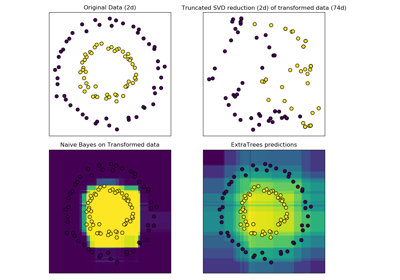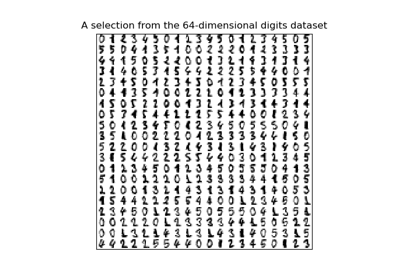sklearn.ensemble.RandomTreesEmbedding¶
-
class
sklearn.ensemble.RandomTreesEmbedding(n_estimators=’warn’, max_depth=5, min_samples_split=2, min_samples_leaf=1, min_weight_fraction_leaf=0.0, max_leaf_nodes=None, min_impurity_decrease=0.0, min_impurity_split=None, sparse_output=True, n_jobs=None, random_state=None, verbose=0, warm_start=False)[source]¶ An ensemble of totally random trees.
An unsupervised transformation of a dataset to a high-dimensional sparse representation. A datapoint is coded according to which leaf of each tree it is sorted into. Using a one-hot encoding of the leaves, this leads to a binary coding with as many ones as there are trees in the forest.
The dimensionality of the resulting representation is
n_out <= n_estimators * max_leaf_nodes. Ifmax_leaf_nodes == None, the number of leaf nodes is at mostn_estimators * 2 ** max_depth.Read more in the User Guide.
Parameters: - n_estimators : integer, optional (default=10)
Number of trees in the forest.
Changed in version 0.20: The default value of
n_estimatorswill change from 10 in version 0.20 to 100 in version 0.22.- max_depth : integer, optional (default=5)
The maximum depth of each tree. If None, then nodes are expanded until all leaves are pure or until all leaves contain less than min_samples_split samples.
- min_samples_split : int, float, optional (default=2)
The minimum number of samples required to split an internal node:
- If int, then consider
min_samples_splitas the minimum number. - If float, then
min_samples_splitis a fraction andceil(min_samples_split * n_samples)is the minimum number of samples for each split.
Changed in version 0.18: Added float values for fractions.
- If int, then consider
- min_samples_leaf : int, float, optional (default=1)
The minimum number of samples required to be at a leaf node. A split point at any depth will only be considered if it leaves at least
min_samples_leaftraining samples in each of the left and right branches. This may have the effect of smoothing the model, especially in regression.- If int, then consider
min_samples_leafas the minimum number. - If float, then
min_samples_leafis a fraction andceil(min_samples_leaf * n_samples)is the minimum number of samples for each node.
Changed in version 0.18: Added float values for fractions.
- If int, then consider
- min_weight_fraction_leaf : float, optional (default=0.)
The minimum weighted fraction of the sum total of weights (of all the input samples) required to be at a leaf node. Samples have equal weight when sample_weight is not provided.
- max_leaf_nodes : int or None, optional (default=None)
Grow trees with
max_leaf_nodesin best-first fashion. Best nodes are defined as relative reduction in impurity. If None then unlimited number of leaf nodes.- min_impurity_decrease : float, optional (default=0.)
A node will be split if this split induces a decrease of the impurity greater than or equal to this value.
The weighted impurity decrease equation is the following:
N_t / N * (impurity - N_t_R / N_t * right_impurity - N_t_L / N_t * left_impurity)
where
Nis the total number of samples,N_tis the number of samples at the current node,N_t_Lis the number of samples in the left child, andN_t_Ris the number of samples in the right child.N,N_t,N_t_RandN_t_Lall refer to the weighted sum, ifsample_weightis passed.New in version 0.19.
- min_impurity_split : float, (default=1e-7)
Threshold for early stopping in tree growth. A node will split if its impurity is above the threshold, otherwise it is a leaf.
Deprecated since version 0.19:
min_impurity_splithas been deprecated in favor ofmin_impurity_decreasein 0.19. The default value ofmin_impurity_splitwill change from 1e-7 to 0 in 0.23 and it will be removed in 0.25. Usemin_impurity_decreaseinstead.- sparse_output : bool, optional (default=True)
Whether or not to return a sparse CSR matrix, as default behavior, or to return a dense array compatible with dense pipeline operators.
- n_jobs : int or None, optional (default=None)
The number of jobs to run in parallel for both
fitandpredict.Nonemeans 1 unless in ajoblib.parallel_backendcontext.-1means using all processors. See Glossary for more details.- random_state : int, RandomState instance or None, optional (default=None)
If int, random_state is the seed used by the random number generator; If RandomState instance, random_state is the random number generator; If None, the random number generator is the RandomState instance used by
np.random.- verbose : int, optional (default=0)
Controls the verbosity when fitting and predicting.
- warm_start : bool, optional (default=False)
When set to
True, reuse the solution of the previous call to fit and add more estimators to the ensemble, otherwise, just fit a whole new forest. See the Glossary.
Attributes: - estimators_ : list of DecisionTreeClassifier
The collection of fitted sub-estimators.
References
[R6e47e53bacbd-1] P. Geurts, D. Ernst., and L. Wehenkel, “Extremely randomized trees”, Machine Learning, 63(1), 3-42, 2006. [R6e47e53bacbd-2] Moosmann, F. and Triggs, B. and Jurie, F. “Fast discriminative visual codebooks using randomized clustering forests” NIPS 2007 Methods
apply(self, X)Apply trees in the forest to X, return leaf indices. decision_path(self, X)Return the decision path in the forest fit(self, X[, y, sample_weight])Fit estimator. fit_transform(self, X[, y, sample_weight])Fit estimator and transform dataset. get_params(self[, deep])Get parameters for this estimator. set_params(self, \*\*params)Set the parameters of this estimator. transform(self, X)Transform dataset. -
__init__(self, n_estimators=’warn’, max_depth=5, min_samples_split=2, min_samples_leaf=1, min_weight_fraction_leaf=0.0, max_leaf_nodes=None, min_impurity_decrease=0.0, min_impurity_split=None, sparse_output=True, n_jobs=None, random_state=None, verbose=0, warm_start=False)[source]¶
-
apply(self, X)[source]¶ Apply trees in the forest to X, return leaf indices.
Parameters: - X : array-like or sparse matrix, shape = [n_samples, n_features]
The input samples. Internally, its dtype will be converted to
dtype=np.float32. If a sparse matrix is provided, it will be converted into a sparsecsr_matrix.
Returns: - X_leaves : array_like, shape = [n_samples, n_estimators]
For each datapoint x in X and for each tree in the forest, return the index of the leaf x ends up in.
-
decision_path(self, X)[source]¶ Return the decision path in the forest
New in version 0.18.
Parameters: - X : array-like or sparse matrix, shape = [n_samples, n_features]
The input samples. Internally, its dtype will be converted to
dtype=np.float32. If a sparse matrix is provided, it will be converted into a sparsecsr_matrix.
Returns: - indicator : sparse csr array, shape = [n_samples, n_nodes]
Return a node indicator matrix where non zero elements indicates that the samples goes through the nodes.
- n_nodes_ptr : array of size (n_estimators + 1, )
The columns from indicator[n_nodes_ptr[i]:n_nodes_ptr[i+1]] gives the indicator value for the i-th estimator.
-
feature_importances_¶ - Return the feature importances (the higher, the more important the
- feature).
Returns: - feature_importances_ : array, shape = [n_features]
The values of this array sum to 1, unless all trees are single node trees consisting of only the root node, in which case it will be an array of zeros.
-
fit(self, X, y=None, sample_weight=None)[source]¶ Fit estimator.
Parameters: - X : array-like or sparse matrix, shape=(n_samples, n_features)
The input samples. Use
dtype=np.float32for maximum efficiency. Sparse matrices are also supported, use sparsecsc_matrixfor maximum efficiency.- sample_weight : array-like, shape = [n_samples] or None
Sample weights. If None, then samples are equally weighted. Splits that would create child nodes with net zero or negative weight are ignored while searching for a split in each node. In the case of classification, splits are also ignored if they would result in any single class carrying a negative weight in either child node.
Returns: - self : object
-
fit_transform(self, X, y=None, sample_weight=None)[source]¶ Fit estimator and transform dataset.
Parameters: - X : array-like or sparse matrix, shape=(n_samples, n_features)
Input data used to build forests. Use
dtype=np.float32for maximum efficiency.- sample_weight : array-like, shape = [n_samples] or None
Sample weights. If None, then samples are equally weighted. Splits that would create child nodes with net zero or negative weight are ignored while searching for a split in each node. In the case of classification, splits are also ignored if they would result in any single class carrying a negative weight in either child node.
Returns: - X_transformed : sparse matrix, shape=(n_samples, n_out)
Transformed dataset.
-
get_params(self, deep=True)[source]¶ Get parameters for this estimator.
Parameters: - deep : boolean, optional
If True, will return the parameters for this estimator and contained subobjects that are estimators.
Returns: - params : mapping of string to any
Parameter names mapped to their values.
-
set_params(self, **params)[source]¶ Set the parameters of this estimator.
The method works on simple estimators as well as on nested objects (such as pipelines). The latter have parameters of the form
<component>__<parameter>so that it’s possible to update each component of a nested object.Returns: - self
-
transform(self, X)[source]¶ Transform dataset.
Parameters: - X : array-like or sparse matrix, shape=(n_samples, n_features)
Input data to be transformed. Use
dtype=np.float32for maximum efficiency. Sparse matrices are also supported, use sparsecsr_matrixfor maximum efficiency.
Returns: - X_transformed : sparse matrix, shape=(n_samples, n_out)
Transformed dataset.




